
UNICEF Supply Annual Report 2023 Supply 360°


UNICEF Supply Annual Report 2023 Supply 360°
UNICEF Supply Annual Report 2023
Supply 360°
SUPPLY COMMUNITY
© UNICEF/UNI497495/Tran Bao An
 Children in Soc Trang, Viet Nam, enjoy access to free, high-quality, digital reading material in Vietnamese and sign language.
Children in Soc Trang, Viet Nam, enjoy access to free, high-quality, digital reading material in Vietnamese and sign language.

This report provides a 360° overview of the supply results for children delivered by UNICEF and partners across the globe. Amidst escalating emergencies, the compounding impact of a global polycrisis and the ongoing need for sustainable development, our commitment to child rights has never been more crucial.
Emergencies in 2023 unfolded at an unprecedented rate. From natural disasters to conflicts, the year was marked by a record number of overlapping crises. Through a strong and agile response powered by partnerships, UNICEF provided $893.07 million in life-saving supplies to children in 81 countries – including in many hard-to-reach locations – before, during and after emergencies.
Immunization supply chains supported by UNICEF delivered 2.790 billion doses of vaccines to prevent deadly diseases such as cholera, HPV, malaria and polio, enough to reach 45 per cent of the world’s children under 5 years old. Together with partners, UNICEF leveraged innovative technologies that better enable immunization supply chains to meet immediate needs of children and their communities and, in the longer term, secure healthier futures.
Localization envisions a future where life-saving supplies for children serve as a catalyst for local empowerment and economic growth. In 2023, UNICEF supported concerted efforts by government in strengthening local production and procurement capabilities, ensuring that every child has timely access to supplies that comply with global standards of quality through a strong, local supply network.
Sustainability is a must and a core value for UNICEF. In 2023, UNICEF Supply Division developed its Sustainability Roadmap and completed a comprehensive greenhouse gas emissions (GHG) baseline assessment of its supply chain, as well as initiating sustainability efforts including solar projects, green buildings, plastic waste reduction and packaging material reuse.
Digitalization has been a key component of UNICEF supply work for the past decade. In 2023, UNICEF continued its focus on digitalization projects that enhance transparency and efficiency, bolster decision-making and strengthen collaboration through more agile, real-time analytic and data sharing.
Innovation across products and processes continues to be a key driver in UNICEF’s efforts to adapt and respond to the ever-changing needs of the children and communities we serve, ensuring that solutions are both effective and forward-looking.
The UNICEF Supply Community and our extensive network of strategic partnerships were at the heart of all our work for children in 2023, underlining the importance and power of collective action.
Our achievements during the year are a testament to what we can accomplish when we come together with a shared resolve for a better world for every child.
 Leila Gharagozloo Pakkala Director, UNICEF Supply Division
Leila Gharagozloo Pakkala Director, UNICEF Supply Division
Ensuring every child survives and thrives by strengthening governmentoperated and -regulated primary health care supply chains and supporting national vaccination targets and access to essential nutrition supplies.
Ensuring every child has an equitable chance in life by providing cash and voucher assistance that enables families to exercise their own choices in purchasing supplies and services available in local markets.
Ensuring every child lives in a safe and clean environment by addressing global challenges related to water, sanitation and hygiene (WASH) and improving access to clean drinking water, sanitation facilities and hygiene supplies.
Ensuring every child learns by providing a wide array of education supplies that are child-friendly, age-appropriate, gender and culturally sensitive, including fit-for-purpose kits as well as assistive and inclusive education items.
Ensuring every child is protected from violence and exploitation by delivering supplies to support positive mental health and psychosocial wellbeing for children and adolescents, especially those on the move or caught in emergencies and protracted crises.



quantifies needs so that adequate supply stocks are available. This helps governments, donors and industry partners plan for the future.
supports governments to sustainably self-finance essential supplies.
UNICEF works with suppliers and the private sector to secure the best value for money and strengthen governments’ procurement capacity.
enables governmwents and other partners to use UNICEF’s procurement scale and decades-long expertise to access affordable quality products and bridge temporary budget shortfalls.
transforms ideas into tangible and scalable solutions, bringing to life new products and processes that are fit-for-purpose and reflect value for money.
creates market conditions that enable sustainable access to the supplies and services children need to survive and thrive and stimulates markets by encouraging demand, ushering in new suppliers and innovations to meet it.
headquartered in UNICEF’s Global Supply Hub in Copenhagen and complemented by strategically located hubs in Dubai, Guangzhou, Panama City and Brindisi, dispatches emergency supplies 24/7 to emergencies and regular programmes globally.
arranges shipments from UNICEF supply hubs and directly from suppliers to destination countries by air, sea and land.
contracts local road cargo transporters, aircraft charters and customs and warehousing services to deliver supplies to communities.
supports government to independently and sustainably manage their supply chains and develops local supply chain workforce capacity..
leverages quantitative and qualitative information to understand supply chain dynamics, communicate on supply chain topics and ensure informed strategies are developed for effective procurement and distribution.
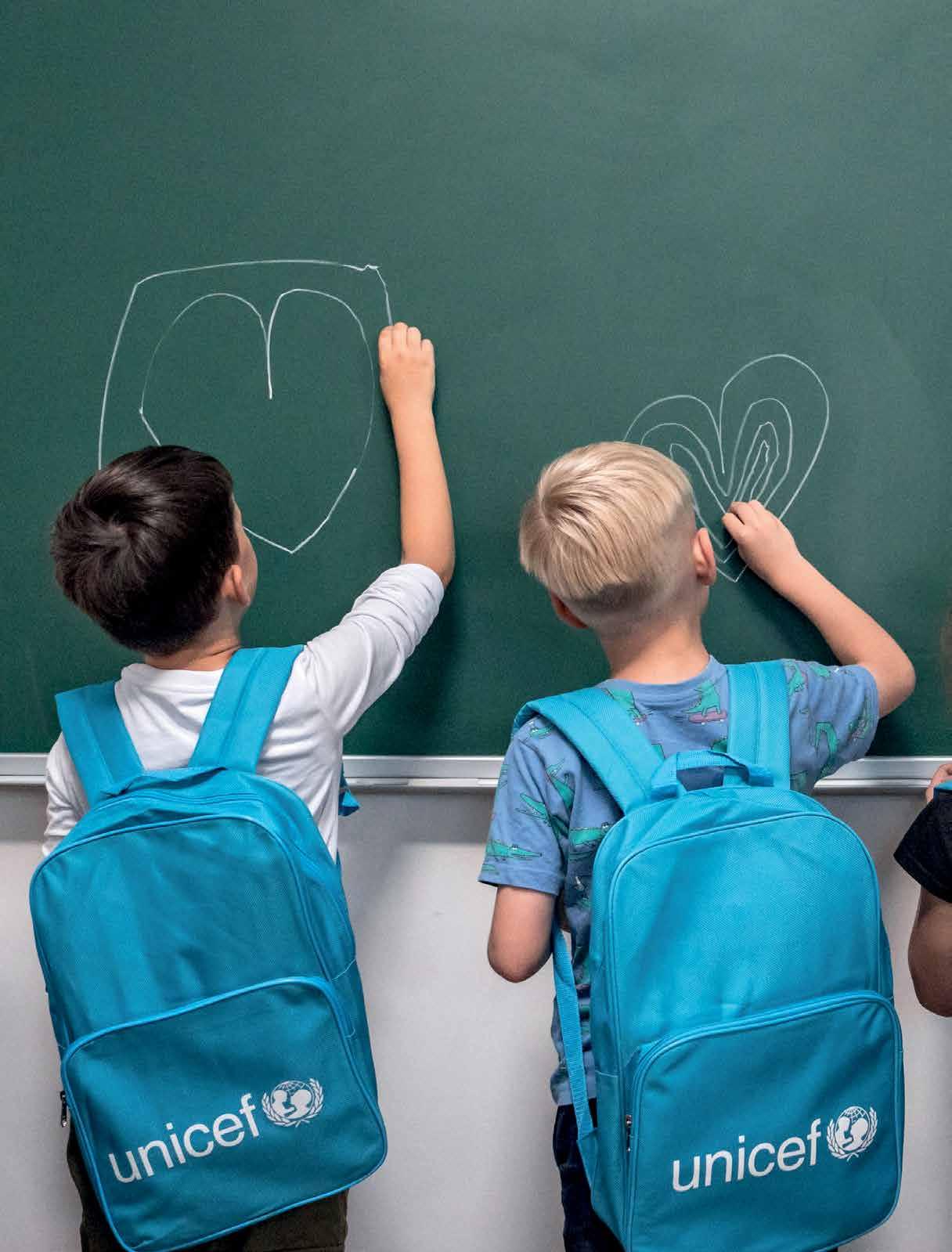
IN 2023, UNICEF PROCURED $5.244 BILLION IN SUPPLIES AND SERVICES – AN EXPRESSION OF OUR COMMITMENT AND STRATEGIC COLLABORATION TOWARDS MORE EQUITABLE ACCESS.

Supporting the Government's Back to School campaign for vulnerable children in Romania, including refugee children from Ukraine, UNICEF delivered over 43,000 backpacks and education supplies for 700 classrooms, along with 3,000 laptops, 500 recreation kits, 100 math and science teaching kits, 100 first aid kits, and 40,000 multilingual learning support materials for the new academic year. © UNICEF/UNI456021/Moldovan.
In 2023, UNICEF procured $5.244 billion in supplies and services for children in 162 countries and areas.
UNICEF’s total 2023 procurement value represents a 37 per cent increase compared to pre-pandemic procurement (2019).
76 per cent of supplies procured was conducted in collaboration with United Nations agencies and other humanitarian and development partners.
The procurement of supplies and services from suppliers registered in programme countries* amounted to $2.727 billion or 52 per cent.
*This figure reflects where suppliers are registered.
$5.244 billion SERVICES $1.744 billion SUPPLIES $3.500 billion 33% 67%
Other
Other

Construction services
$297.6M Contracted personnel**
$183.9M
$195.9M Cash and voucher assistance
International freight $182.7M
$140.2M
In-country logistics and warehousing services
$87.7M
Research, surveys, monitoring and evaluation services

** to share expertise with partner governments, implement social mobilization campaigns and provide temporary labour for programmes.
$2.211B
Vaccines/biologicals
UNICEF provided Procurement Services to governments and other development partners resulting in $2.364 billion worth of supplies and services delivered to 129 countries.
• 92 self-financing governments
• Gavi, the Vaccine Alliance, in 75 countries
• United Nations agencies in 71 countries
• Access to COVID-19 Tools Accelerator Supplies Financing Facility (ACT-A SFF) in 62 countries
• 31 countries financed by the Global Fund
• Non-governmental organizations in 35 countries
$148.6M Pharmaceuticals
$105.9M
Cold chain equipment
• 36 countries financed by development banks
• 7 countries financed by other international funding agencies
Globally, emergency supplies worth $893.07 million were delivered to 81 countries and areas.
13,133 shipments transporting 161.15 million metric tons of supplies.
THE UNICEF SUPPLY COMMUNITY AT THE FOREFRONT OF OUR RESULTS
1,343 STAFF
205
AREAS OF SUPPLY EXPERTISE Contracting
Product
Supply
COPENHAGEN
BRINDISI
$188.18 million in supplies were delivered to 135 countries and areas from UNICEF Global Supply and Logistics Hubs.
Homa, 8, and Humaira, 12, are survivors of a devastating earthquake that leveled their home in Herat, Afghanistan. Hygiene kits help maintain hygiene levels and a sense of dignity for children and their parents in the wake of emergencies.
© UNICEF/UNI466880/Khan
$858 million in supplies were delivered across 73 countries from 221 active warehouses.

Countries from which UNICEF procurement of supplies and services exceeded $10 million, based on country of invoice (in $ millions).
11,666
suppliers in 176 countries

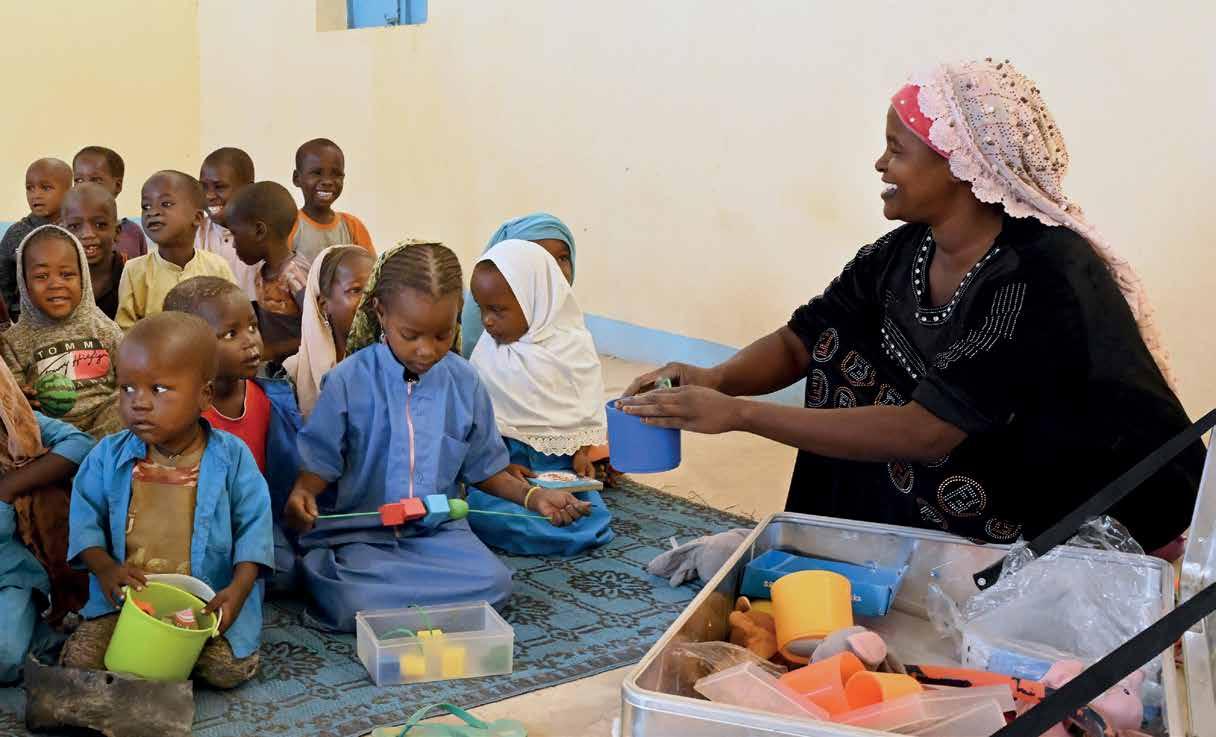
$15 million – $20 million
Niger (the)
Haiti $19.3
Italy $19.2
$19.5
Côte d’Ivoire $19.1
Brazil $17.9
Venezuela (Bolivarian Republic of) $17.6
Burkina Faso $17.5
$10 million – $15 million
48% from suppliers in donor countries and areas
52% from suppliers in programme countries and areas
DELIVERING 360°
Spotlight on some of the supplies UNICEF delivers for every child to survive and thrive.
$11.4 million worth of respiratory support devices to 55 countries
2.790 billion vaccine doses to 105 countries, enough to reach 45 per cent of the world’s children under 5 years old
2.4 million backpacks to 24 countries
1.225 billion water purification tablets to 53 countries, enough to treat 26.5 billion litres of water

13.4 million Long-lasting insecticidal nets (LLIN) to 32 countries
$38.7 million worth of IT equipment for educational purposes to 11 countries
1.1 billion sachets of ready-touse therapeutic food (RUTF) to 75 countries 9,006
High Performance Tents (HPT) to 58 countries
405,847 UNICEF KITS DELIVERED TO 88 COUNTRIES
121,114 MEDICAL KITS
49,902 WASH & DIGNITY KITS
234,831 EDUCATION KITS
All UNICEF supplies must be appropriate to country and cultural contexts and meet international standards for quality, safety and sustainability. To make sure our supplies are always fit for purpose, it’s important to know what children, caretakers and communities think about the supplies they receive. This feedback is essential for us to inform our commitment to continuous improvement.
During an emergency response, collecting systematic feedback on the user’s experience can be challenging as their insights are often relayed indirectly through implementing partners and staff.
In late 2022, UNICEF launched Kits That Fit to empower individuals in voicing their feedback about emergency supplies – what they need and their thoughts about the supplies they received.
Kits That Fit is a multi-language, anonymized platform end-users can
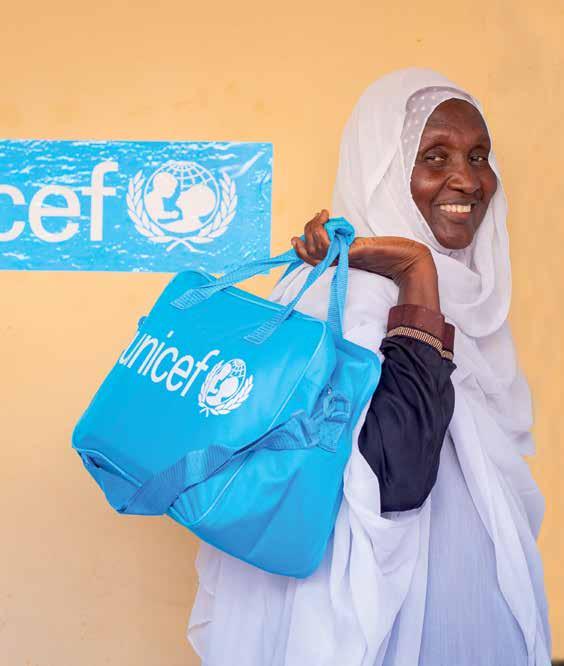
recreation kits
42,791 Early Childhood Development kits 4,453 country-specific classroom kits 978 adolescent kits
access via QR code, text or phone. It runs on UNICEF’s mainstreamed technologies such as RapidPro for mobile text and the Internet of Good Things for low-bandwidth environments to confidentially collect user feedback.
In 2023, UNICEF piloted the platform across Kenya, the State of Palestine, Türkiye and Ukraine, receiving thousands of inputs that helped to update and refine contents of UNICEF emergency kits.
Thank you for the wonderful set for women! Everything necessary and appropriate for hygiene. Many thanks from me and my daughter.”
Excerpt from a Ukrainian mother’s feedback via Kits That Fit
I can’t describe how I felt when I received the Midwifery Kit. Now, I am ready to support mothers with these supplies. I can save the lives of both the mother and child,”
Amira Khamis, a displaced midwife from Khartoum, Sudan
Supply and Procurement
Associate, UNICEF Madagacar Country Office
I am incredibly proud to be part of the strong team effort to deliver the UNICEF School-in-a-Box filled with high-quality education supplies to students through the Back to School initiative in Madagascar. We supply children with all the essentials for the best possible start today, while they supply the world with the promise of a better tomorrow.

YEAR-ON-YEAR, EMERGENCIES HAVE INCREASED IN SCALE, URGENCY AND COMPLEXITY. UNICEF RESPONDED TO MORE EMERGENCIES IN 2023 THAN IN ANY PREVIOUS YEAR – FROM NATURAL DISASTERS TO CONFLICTS AND WARS.
A girl sits on the side of the road waiting to fill water cans in Khan Younis City in the Gaza Strip, State of Palestine. © UNICEF/UNI485705/El Baba
No region has been spared. In 2023, UNICEF delivered $893.07 million in emergency supplies to 81 countries and areas. UNICEF responded to the Syria and Türkiye earthquakes, conflict and unrest in the Democratic Republic of the Congo, Haiti, the State of Palestine, Sudan and Ukraine and other crises. In 2023, UNICEF estimated that nearly a quarter of the world’s children were living in or fleeing from conflict zones.
In the face of growing humanitarian crises, UNICEF mounted large-scale supply responses and quickly mobilized essential supplies to support life-saving relief, early recovery, longterm development and preparedness for the future. UNICEF demonstrated remarkable agility in facing these crises head-on and remained steadfast in its commitment to meeting the expanding needs of vulnerable populations.
EMERGENCY SUPPLY RESPONSE OVERVIEW
Significant civil unrest destabilized much of the country. The humanitarian crisis was exacerbated by outbreaks of measles and cholera and a deteriorating nutrition situation. UNICEF responded with essential supplies and the deployments of Supply Community experts, while addressing daily access challenges and disruption of the in-country logistics capacity.
The rapid spread of cholera in over 30 countries around the world triggered alarm. In early 2023, UNICEF pre-emptively doubled the quantity of key cholera response supplies anticipating the significant needs to come. (Read more on page 24.)
The escalation of the war in Ukraine in its second year saw continued critical interventions from UNICEF in 2023. UNICEF sourced generators to keep critical infrastructure running, as well as procuring and delivering children’s winter clothing kits and education and recreation supplies. UNICEF also supported the rehabilitation of schools and shelters and distribution of laptops and tablets for learning .
$893.07 million IN EMERGENCY SUPPLIES
Sudden intense clashes between the country’s military and main paramilitary force resulted in thousands of people fleeing the capital Khartoum in April 2023. As the fighting moved and the war worsened, more and more civilians left their homes in search of safety. The displaced population traveled not only to other areas of Sudan, but also across borders into the Central African Republic, Chad, Egypt and South Sudan. UNICEF responded with immunization, medical, nutrition, education, child protection, shelter and WASH supplies.
The ongoing escalation of hostilities in the Gaza Strip has displaced 1,7 million people – half of them children – mostly to the south of the Strip. Despite many limitations in terms of aid access to and within the Gaza Strip, UNICEF mounted a large-scale humanitarian aid response, organizing 29 charters with over 1,000 metric tons of emergency supplies to Al Arish in Egypt where critical life-saving supplies are trucked into Gaza Strip. Fifteen Supply Community experts were deployed to provide technical expertise in supply planning, local sourcing and procurement, logistics, strategy development and risk and access mapping.
Growing civil unrest coupled with measles and cholera outbreaks and large-scale internal displacement required quick humanitarian support of emergency medical kits, nutrition supplies, HPTs and LLINs. UNICEF scaled the delivery of emergency supplies and deployed Supply Community experts in Goma to support in-country logistics.

“I am happy to be back in school and to meet my friends,” says Keziah, 7, who returned to school after a series of cyclones in Vanuatu. © UNICEF/ UN0820669/Shing
OF COUNTRIES EXPERIENCING L2 AND L3 EMERGENCIES
UNICEF and other United Nations agencies use a tiered framework to classify the biggest emergencies requiring the mobilization of system-wide response as Level 2 and Level 3 (L2 and L3).
In 2023, a global exercise to reinvigorate the roster culminated in the identification of 350 qualified and experienced staff across 14 functional areas. Of the 58 Supply Community colleagues deployed to 17 emergency locations in 2023, a remarkable 70 per cent had joined the newly launched roster within that year. UNICEF Supply Division also hosted the first post-COVID, in-person emergency preparedness and response training, which included a two-day simulation of an L3 earthquake supply response, attended by 33 colleagues from 27 UNICEF offices.
Listed by onset date
* Ethiopia, Kenya and Somalia
** Bulgaria, Czechia, Hungary, Moldova, Poland, Romania and Slovakia
*** Benin, Burkina Faso, Côte d’Ivoire, Ghana, Guinea, Mali, Niger and Togo.
**** .Afghanistan, Benin, Burkina Faso, Burundi, Cameroon, Chad, Democratic Republic of the Congo, Ethiopia, Haiti, Iraq, Kenya, Lebanon, Malawi, Mali, Mozambique, Niger, Nigeria, Pakistan, Yemen, Somalia, South Sudan, Sudan, Syrian Arab Republic, United Republic of Tanzania, Zambia and Zimbabwe
Nepal
State of Palestine
Libya
Ethiopia
Armenia
Chad
Sudan
Democratic Republic of the Congo
Multiple countries**** (Cholera outbreak)
Madagascar, Malawi and Mozambique (Cyclone Freddy)
Vanuatu, Fiji and Kiribati (Cyclones) Cameroon, Gabon and Guinea (Marburg outbreak)
Syria and Türkiye (Earthquake)
Uganda
Pakistan
Ukraine refugees** Sahel***
Ukraine
Afghanistan
Haiti
Myanmar
Ethiopia
Yemen
Horn of Africa*
Declared emergencies
Undeclared emergencies
On 10 September 2023, torrential rain from Storm Daniel created flash floods in northeastern Libya. Multiple cities and towns were affected. The tremendous volume of water caused two dams to burst, flooding the city of Derna. UNICEF deployed Supply Community experts to support and reinforce the efforts of national teams on the ground.
The UNICEF Libya Country Office responded immediately with over 8,000 locally procured hygiene kits. Distribution was supported by the Libyan Red Cross. 24h
 DERNA Libya
DERNA Libya
As needs rapidly escalated, UNICEF quickly established an agreement with the Ministry of Health to utilize its warehouse in Benghazi as well as the Libyan Red Crescent warehouse to accommodate supplies arriving from the UNICEF Global Supply and Logistics Hubs in Copenhagen and Dubai.
UNICEF coordinated two chartered flights, and loaded and delivered 30 metric tons of shelter, medical and WASH-related supplies – enough for 135,000 individuals.
In Türkiye, feedback elicited via the Kits That Fit digital platform helped UNICEF refine its emergency supply response. UNICEF received 659 written responses, mainly from parents and young people who received a standard WASH kit. Their feedback outlined suggestions for refining the kit to better suit the needs of children and families in crises.
In response, UNICEF created three specialized hygiene kits for families, mothers and infants. This evolution from one generic WASH kit to four specifically targeted standalone kits enhanced the delivery of genderappropriate items, such as undergarments, menstrual products, and adult diapers, reaching over 907,000 individuals. This feedback enables UNICEF to understand the precise needs of children and communities in crisis and ensure that support to children and families is both impactful and relevant to their real needs.
During early recovery efforts, UNICEF provided temporary buildings as mobile clinics, furniture and education supplies to 11 schools for children resuming their studies. This was in addition to procuring 91 metric tons of emergency supplies delivered over four charted flights.
In the subsequent wave of the response, two additional chartered flights, one of which secured through the inkind support of Flexport.org, brought more health, nutrition and WASH supplies, as well as education materials to support child-friendly spaces.
Administrative Associate, UNICEF Vanuatu Field Office
My home, Vanuatu, is spread across 83 islands and getting supplies to affected areas takes time. It is situated in a cyclone-prone area and the force and frequency of which we experience cyclones is growing every year. Tropical Cyclone Pam, which devastated the country in 2015, was a turning point for me. I joined UNICEF to help the emergency response after seeing my friends and neighbours lose their livelihoods.
In 2023, we responded to three cyclones, including two of Category 5. We were still responding to the needs of families from the first cyclone when an immediate second and then a third hit in November 2023.
When I see the destruction of a cyclone, I want to be immediately there to assist. I will work seven days a week and during the night to move supplies – education supplies for children, rehabilitation of schools, shelter for affected communities and safe water to all.
The delivery of UNICEF emergency supplies depends on cost-efficient and timely logistics. Transporting supplies to Sudan involved a series of steps: Initially, life-saving supplies were flown into Dubai, the United Arab Emirates; next, they were trucked to Jeddah, Saudi Arabia; and, finally, ferried to Port Sudan, Sudan. Intermodal transportation improved the speed of delivery and significantly reduced costs. Drawing on this experience, the same model was applied to UNICEF’s response to Gaza with the State of Palestine. Critical supplies were transported by road from Dubai to Amman, Jordan, and then via ferry to Nuweibaa, Egypt, and finally crossing into the Gaza Strip.
Nuweibaa
CMA CGM Foundation donated cargo space equivalent to over 500 containers, benefiting almost 50 countries. The donation allowed UNICEF to ship vital supplies in response to cholera outbreaks, education in emergencies and malnutrition.
The European Union (EU) facilitated the transportation of critical emergency supplies to both the Democratic Republic of the Congo and the State of Palestine through the EU Humanitarian Air Bridge. In the initial weeks of the response to the State of Palestine, the EU, working alongside UNICEF, provided air transport for more than 500 metric tons of essential supplies, enabling flexible and fast response in support of the children and families living in the Gaza Strip. The shipments included health, shelter, WASH, education and protection supplies among others.
In 2023, Flexport.org donated transportation to support UNICEF emergency response in 13 countries, including Afghanistan, Chad, Ethiopia, Syria and Zimbabwe. The contributions enabled UNICEF to overcome supply bottlenecks in locations where the complex nature of crises put children at increased risk.
For example, following the July 2023 coup d’état in Niger, border closures prevented supplies from entering the country by road and jeopardized the continuity of nutrition programming.
To avoid a stockout, Flexport.org donated air transport to move 13,280 cartons of RUTF from Accra, Ghana, to Niamey, Niger. This support leveraged existing prepositioned stock in Ghana and ensured uninterrupted access for over 13,000 children suffering from Severe Acute Malnutrition (SAM).

EVERY YEAR, UNICEF PROCURES ENOUGH VACCINES TO REACH 45 PER CENT OF THE WORLD’S CHILDREN UNDER 5 YEARS OLD.
IN 2023, UNICEF DELIVERED 2.790 BILLION VACCINE DOSES TO 105 COUNTRIES. THIS INCLUDES DELIVERING 2.686 BILLION DOSES TO 102 COUNTRIES TO SUPPORT THEIR NATIONAL VACCINATION TARGETS AND OUTBREAK RESPONSE.

Health workers make a two-hour boat ride to reach Fulkakata village in Dhubri district, Assam, India, carrying vaccines in cold boxes. This is essential to preserve the cold chain, a temperature-controlled supply chain that keeps vaccines at the right temperature from the moment they are manufactured to administration, ensuring their effectiveness and safety. © UNICEF/ UN0804040/Baruah
UNICEF contributed to a 2,500 per cent increase in human papillomavirus (HPV) vaccine delivery compared to 2019 and the introduction of a newly available vaccine for malaria, as well as delivering 1.62 billion doses to prevent polio and 36 million doses to respond to cholera outbreaks.
UNICEF’s technical expertise spans the entire immunization supply chain, encompassing demand forecasting, strategic procurement and logistics services. Related supplies include syringes, safety boxes and cold chain equipment.

Over decades, market shaping efforts have enabled UNICEF to negotiate lower pricing and incentivize competition among manufacturers. Alongside global health partners, UNICEF supports government efforts to strengthen immunization systems by investing in the capacity building of health workers, upgrading and expanding cold chain capacity and introducing electronic management information systems to track progress.
In 2023, UNICEF delivered 1.362 billion doses of oral polio vaccine (OPV), out of which 510 million doses comprised the oral polio vaccine type 2 (nOPV2) – a recently prequalified vaccine that effectively mitigates outbreaks of type 2 variant poliovirus (cVDPV2) – the most prevalent form seen in Africa. To meet the increased demand for nOPV2, a technology transfer allowed a second manufacturer to start production. Diversifying the nOPV2 supplier base is critical to achieving vaccine security as envisioned by the global polio vaccine stockpile strategy.
UNICEF supported the procurement of 36 million doses of oral cholera vaccine (OCV) to respond to outbreaks in 30 countries. The speedy delivery of WASH supplies was essential for affected communities to contain the spread of infection and ensure access to safe water. In the Eastern and Southern Africa Region, 13 countries with already fragile health systems were hit especially hard. In 2023, UNICEF successfully increased the available supply of OCV by 30 per cent for 2024.
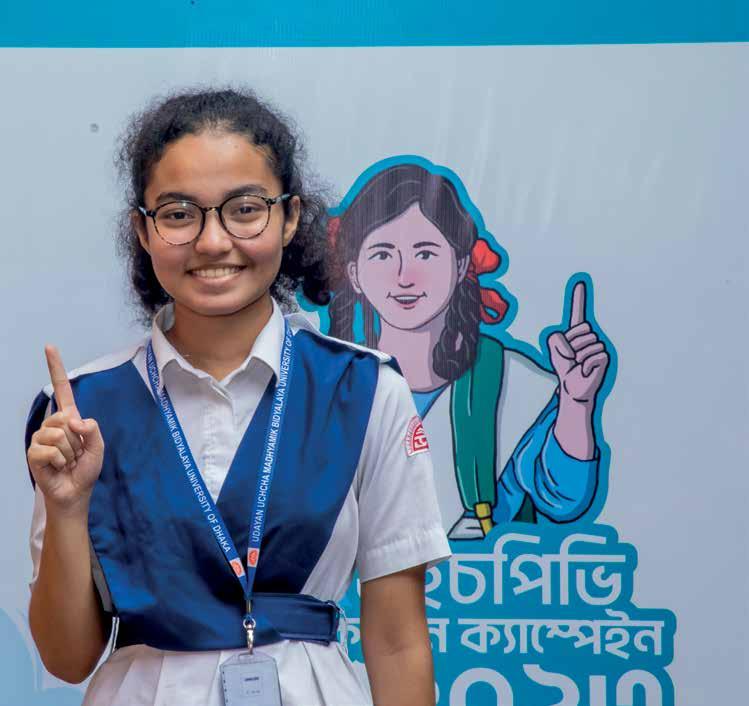

In 2023, following COVID-19 pandemic disruptions, UNICEF delivered 24.3 million doses of HPV vaccine to 47 countries – a remarkable 25-fold increase compared to 2019. Among these countries, Bangladesh, Cambodia, Eswatini, Kiribati, Mongolia, Nigeria and Togo introduced HPV vaccines for the first time into routine immunization programmes, which resulted in an increase in demand. UNICEF and partners’ close engagement with vaccine manufacturers has led to greater supply availability as demand from countries continues to rise.
Girls receive the HPV vaccine during a UNICEF-supported national vaccination campaign at the Udayan Higher Secondary School in Dhaka, Bangladesh. © UNICEF/ UNI493752/Satu

With the COVAX Facility winding down and in preparation for the delivery of COVID-19 vaccines in 50 countries in 2024 under the newly Gavi Board-approved programme, UNICEF worked with partners to transition supply management from an emergency operation under COVAX to a routine programme in line with standard processes and reverting to important UNICEF principles around good-faith contracting, price transparency and manufacturer product liability.
In 2023, UNICEF procured the first commercial doses of the malaria vaccine. 6.23 million doses were delivered to six countries – Burkina Faso, Cameroon, Ghana, Kenya, Malawi and Sierra Leone. Alongside well-established preventive measures such as the use of LLINs and antimalarial medication, the malaria vaccine will help prevent 627,000 deaths a year – 77 per cent of which are children under 5 years old.
Rohulah, 9 months old, is immunized against vaccine-preventable diseases in Badakhshan, Afghanistan. © UNICEF/UNI484146/Haya Burhan
The tender strategy for expanding the inactivated polio vaccine (IPV) supplier base has scaled up production and improved efficiencies. As a result, manufacturers have been able to offer more competitive pricing. Market shaping efforts helped reduce the weighted average price of IPV from $2.00 to $1.70 a dose – achieving an overall savings of $29.4 million for countries in 2023.
Traceability and Verification System (TRVST) is a global system using GS1-enabled barcoding technology to verify the authenticity of vaccines and other health products on the market. It represents a significant step toward improving patient safety and ending the devastating impact of counterfeit medicines. Since its introduction in 2022, suppliers representing 75 per cent of vaccine doses procured by UNICEF have joined TRVST. The increased uptake of TRVST among countries and suppliers is helping to improve supply chain safety and efficiency –and will save lives in the case of product recall or reporting adverse events.
In 2023, UNICEF convened its largestever Vaccine Industry Consultation in Copenhagen. Over 250 participants, from 70 manufacturers and partners, shared updates on key markets as well as programmatic, policy and technical developments. In June 2023, UNICEF held a global Vaccine Procurement Practitioners Exchange Forum (VPPEF), bringing together ministries of health and finance to share experiences and best practices on vaccine procurement. The VPPEF focused on the new vaccine introductions with a particular emphasis on HPV. A vaccine procurement e-course was launched as a publicly available resource to help countries strengthen their vaccine procurement processes.
Cold Chain Equipment and solarization
In 2023, through the Africa Centres for Disease Control and Prevention (Africa CDC), UNICEF delivered $25 million in cold chain equipment to more than 30 countries. Deployment plans were developed in close consultation with Africa CDC. In line with country-level investments into the Cold Chain Equipment Optimization Platform (CCEOP), local Expanded Programme on Immunization (EPI) authorities were mobilized. UNICEF also established eight long-term agreements (LTAs) for the procurement of solar equipment and services. In 2023, the LTAs will support the solarization of over 1,000 health facilities and selected UNICEF offices. UNICEF discontinued supply of vaccine refrigerators and freezers using refrigerant gases with high global warming potential in 2023.
Safe injection equipment manufactured in Africa
Following challenges during the COVID-19 pandemic, the safe injection equipment market has stabilized. UNICEF’s 2023 tender introduced an Africa-based manufacturer from whom over 40 per cent of safe injection equipment for the continent will be sourced. This historic outcome, enabled by a grant from the Bill and Melinda Gates Foundation (BMGF), aligns with the localization strategy for the continent supported by UNICEF. Sourcing products closer to programme countries enhances supply security by improving scale-up capacity during public health emergencies and reducing carbon emissions linked to international freight transport.

Procurement Services Officer, UNICEF Kyrgyzstan Country Office
Four years of advocacy paid off! In 2023, thanks to strong collaboration with our counterparts in the Government of Kyrgyzstan, the country passed amendments to the law on state procurement, allowing the use of UNICEF Procurement Services for the purchase of vaccines.
I worked with my counterparts to push this agenda forward. I may have paved the way, but ultimately it was the collaboration between UNICEF Supply and Programme that got us over the finish line. Because of that, other health-related programmes will benefit from the new legislation, such as the procurement of quality essential medications and oncology medicines for children.
I am engaged in the immunization programme, not only for Procurement Services but also for implementation of other projects that contribute to immunization, such as supply chain and the Cold Chain Equipment Optimization Platform (CCEOP). In 2023, 80 per cent of all vaccination points in Kyrgyzstan were equipped with the specialized cold chain equipment, replacing domestic refrigerators ensuring safe immunization practices and vaccine availability in hard-to-reach areas.
All these efforts have been successful because of close cooperation with immunization and health specialists. I am very proud of the work we are doing together.
UNICEF is a core partner of Gavi, the Vaccine Alliance, and works closely with the World Health Organization (WHO), the Bill and Melinda Gates Foundation (BMGF) and the Coalition for Epidemic Preparedness Innovations (CEPI). Supply and procurement teams work in close collaboration with global health partners such as the Global Polio Eradication Initiative (GPEI), the Measles & Rubella Partnership and the Eliminate Yellow Fever Epidemics (EYE) strategy.
UNICEF co-leads the Vaccine Innovation Prioritization Strategy (VIPS), which aims to accelerate the advancement of immunizationrelated innovations, ultimately reaching children who have not received any vaccinations and increasing vaccine coverage. In 2023, VIPS focused investments on advancing the development of Micro Array Patches (MAPs) and Controlled Temperature Chain (CTC) compliant vaccines.

LOCALIZATION IS A STRATEGIC APPROACH FOCUSED ON STRENGTHENING REGIONAL AND NATIONAL PRODUCTION AND PROCUREMENT OF SUPPLIES AND OPTIMIZING SUPPLY CHAINS TO REACH FINAL DESTINATIONS.
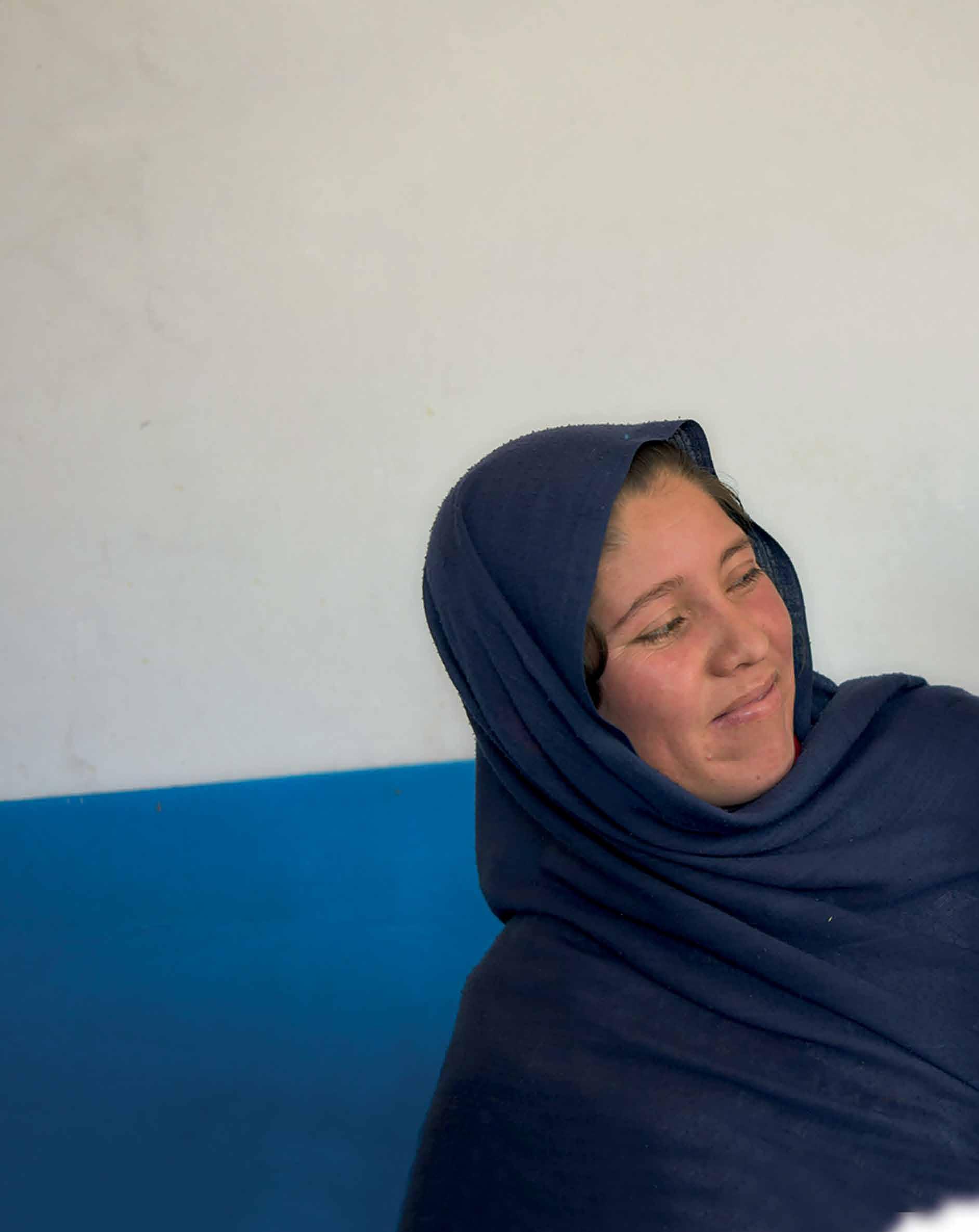
Mahdi, 18-month-old, eats a sachet of RUTF while sitting on his mother at Daikundi Provincial Hospital in Afghanistan. Mahdi had been admitted to the hospital’s inpatient department for treatment of severe acute malnutrition (SAM). However, after passing his appetite test on the day the picture was taken, he was discharged to go home healthy. © UNICEF/UN0838543/Karimi
Localization envisions a future where life-saving supplies for children serve as a catalyst for local empowerment and economic growth. UNICEF continues supporting governments’ localization drive across regions, ensuring that every child has timely access to life-saving supplies that comply with global standards of quality that address health and other issues endemic to a region, through a strong, local supply network.
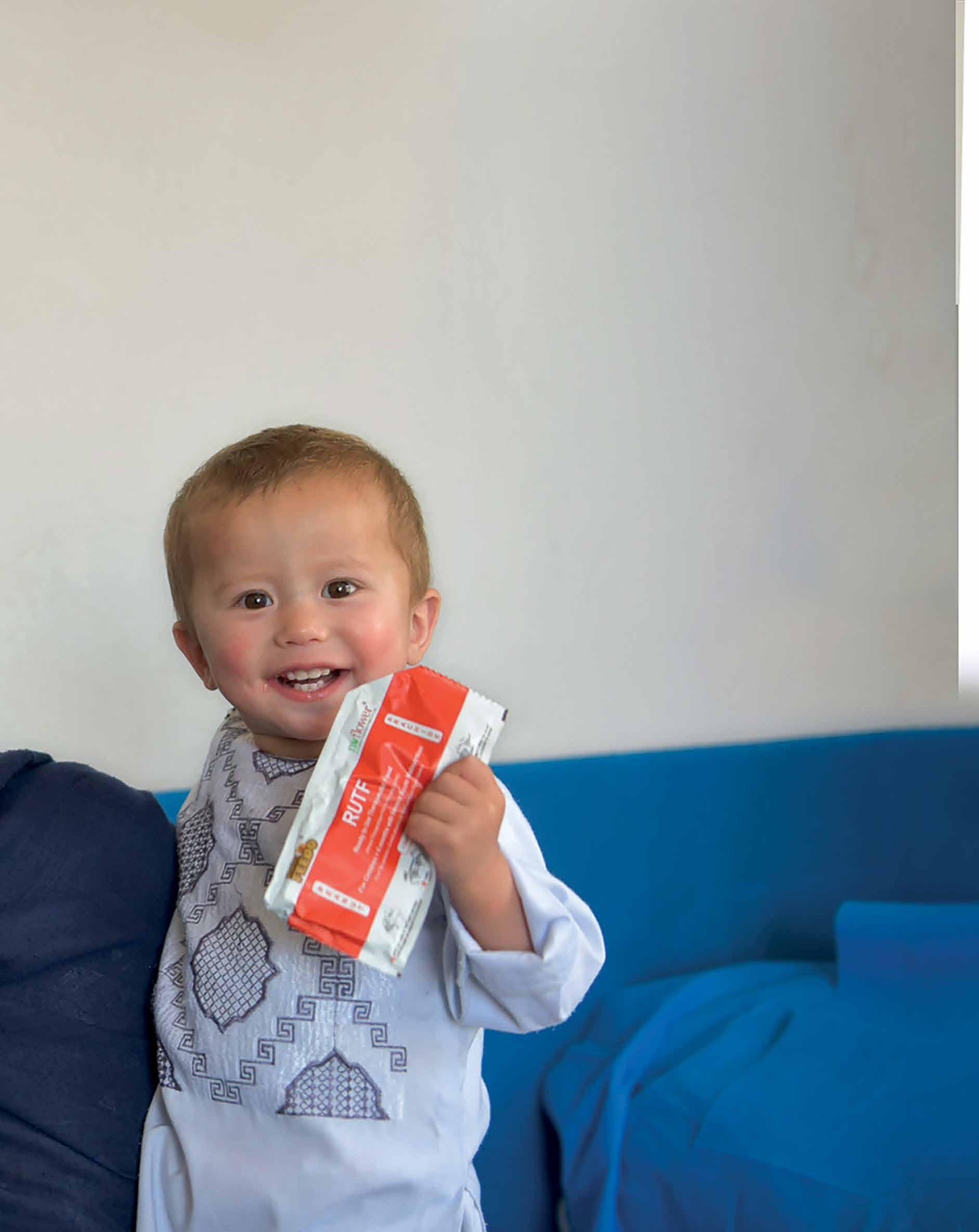
Across regions, UNICEF offices are supporting regional manufacturing and procurement with regional long-term agreements and increased local procurement. Localization is also good news for environmental sustainability. Local procurement will save carbon emissions that would otherwise be produced by international freight transport.
In 2023, UNICEF supported a local production roadmap in Africa targeting the continent’s significant import-export disparities, where the demand for essential supplies heavily relies on imports despite local production potential.
Supporting the local private sector to serve as robust sources of essential supplies, the roadmap outlines a three-phased approach, with efforts across all phases commencing from the outset.
This roadmap builds on established successes that moved supply progressively closer to demand and diversified UNICEF’s supplier base. For instance, since 2006, the RUTF supply market has grown from a single European supplier to 18 vendors, with 75 per cent of them operating in the Global South.

First Wave accelerates the localized production of Oral Rehydration Salts (ORS)/Zinc, syringes and Large Volume Parenterals (LVPs).
Second Wave expands to include LLINs, malaria rapid diagnostic tests, oxygen concentrators and chlorine water treatment solutions.
Third Wave focuses on enabling local production of vaccines, amoxicillin dispersible tablets, multiple micronutrient supplements and cold chain equipment.
To bridge the import-export gap and enhance supply security, specific goals for 2030 include:
• adding three African ORS/Zinc manufacturers to reach four;
• increasing the number of African auto-disable syringe manufacturers to three, and;
• procuring LVPs from at least two African manufacturers.
The roadmap aligns with the Partnerships for African Vaccine Manufacturing (PAVM) initiative’s ambitious aim for 60 per cent of vaccines used in Africa to be produced locally by 2040 and supports the expansion of the supply of African-made pharmaceutical products on the continent.
© UNICEF/UNI419943/Aina
The COVID-19 pandemic exposed the frequent shortage of medical-grade oxygen in low and middle-income countries. As the world grappled with the virus, countries sought oxygen supplies, which were neither readily available nor affordable locally. UNICEF addressed this challenge through the Oxygen Plant-in-a-Box initiative. This innovative solution delivers fully functional oxygen systems to communities, either contained within a single shipping box or shipped in parts for local assembly and operation, ensuring a sustainable local oxygen supply for hospitalized patients, including life-saving oxygen therapy for children with pneumonia – still the leading cause of child mortality globally.

By 2023, significant progress was made, with 30 new oxygen plants becoming operational, bringing the total to 50 plants in 19 countries since the project’s inception in 2021. Emphasizing UNICEF’s commitment to localization, this initiative not only strengthens local capacities for oxygen delivery but also stimulates market demand for oxygen supplies. Utilizing tools like the Oxygen System Planning Tool, UNICEF supports governments’ localized delivery of components and skilled technicians, ensuring sustainable operation and long-term maintenance.
UNICEF’s partnership with Kenya-based Revital Healthcare marked a major milestone in UNICEF’s 2023 local production agenda and has significantly advanced the localization of syringe production in Africa. Fueled by a grant from BMGF, this collaboration has increased WHO-prequalified syringe production while bringing supply closer to demand and improving supply security. Achieving WHO prequalification for an early activation auto-disable syringe, Revital Healthcare aligns with UNICEF’s high safety standards. Sourcing syringes from within the continent significantly reduces shipping time by two to three months compared to procurement outside of Africa, as well as greenhouse gas emissions. Moreover, this effort encourages other African manufacturers to seek WHO prequalification and enter competitive markets.

Water, Sanitation and Education Centre Chief, UNICEF Supply Division
During emergencies, localizing supply chains is crucial for the rapid delivery of life-saving supplies. In 2023, the UNICEF Middle East and North Africa Regional Office (MENARO) and UNICEF Supply Division provided a strategic, regional response to the State of Palestine emergency. Via a comprehensive regional market assessment, followed by an Expression of Interest targeting Egypt, Jordan, Lebanon and Syria, UNICEF aimed to secure a local supply of nine crucial product groups. The request underscored the significance of regional engagement to expedite emergency supply delivery amidst crises.
This localization drive resulted in the rapid establishment of over 12 regional LTAs with local suppliers, significantly enhancing emergency preparedness. By early 2024, six of these LTAs had been activated, notably including winter clothing supplied by two Egyptian manufacturers. This achievement not only exemplifies the tangible benefits of local sourcing but also showcases the successful diversification of the supplier base, with 198 new prescreened local vendors contributing to a robust regional supply network.
UNICEF convened supplier conferences in Amman, Jordan, and Cairo, Egypt, which attracted the
participation of 480 regional suppliers. These events served as important platforms for information exchange on UNICEF and United Nations procurement practices, facilitating collaborative discussions on industry trends and marking a significant step in advancing UNICEF’s localization agenda.
It was great working with the supply teams in MENARO during this rapid market assessment in the midst of the emergency response. This Regional Office–Supply Division collaboration and localization drive resulted in improving access to essential supplies for children. The team’s hard work, resilience, and commitment have been inspiring.
Contracts Specialist, UNICEF Latin America and the Caribbean Regional Office
Over the last five years, the Latin America and Caribbean region has faced increased challenges – from climate change, migration and political instability –affecting countries with heavy import reliance, like those in the Caribbean. This shifting landscape prompted us to rethink our strategy towards a more localized approach, including reopening a regional warehouse and establishing a supply hub to better support rapid response to emergencies and foster local economic growth.
In 2023, the development of LTAs with regional suppliers for essential products such as hygiene kits, education kits and tarpaulins was a crucial step in localizing our supply chain. This strategic shift enables us to be closer to and more prepared to deliver for a swift response when emergencies arise.
The rise in emergencies across Latin America and the Caribbean necessitates a localized approach to emergency response, supporting governments while reducing dependency on supplies from overseas sources. By building up a regional hub, we’re not only enhancing our emergency response capabilities but also investing in local suppliers and job creation. The year 2023 has indeed been a pivotal moment for embracing localization in supply chains for children.
In 2020, UNICEF signed a Procurement Services Memorandum of Understanding with the Africa Centres for Disease Control and Prevention (Africa CDC) and subsequently worked together on the Saving Lives and Livelihoods Initiative. Under this Initiative, UNICEF was mandated to procure vaccines and support the implementation of in-country logistics services, in addition to procuring and installing cold chain equipment.
In 2022, UNICEF and Africa CDC signed a partnership across three key pillars, and in 2023, a UNICEF Supply Division team was outposted to Addis Ababa, Ethiopia, to support localization efforts. The team comprised expertise in procurement, partnership, supply chain strengthening, supply financing, forecasting, quality assurance and market shaping – and has been closely collaborating with the African Union and its key technical agencies such as Africa CDC. Joint efforts have included industry consultations, participation in the Marketplace Forum in Marrakech, Morrocco, and engagement in the Vaccine Procurement Practitioners Exchange Forum (VPPEF) for capacity building and knowledge sharing on vaccine procurement.
A hallmark of this collaboration has been its contribution to the COVID-19 coverage goals set by Africa CDC, facilitating the procurement and delivery of 168 million vaccine doses for 45 countries through partnerships with the African Vaccine Acquisition Trust (AVAT) and the Africa Medical Supplies Platform (AMSP). Moreover, UNICEF and Africa CDC have ensured the effective storage and transportation of COVID-19 and routine immunization vaccines, with substantial orders placed for refrigeration units, cold boxes, vaccine carriers, and refrigerated vehicles across multiple countries, showcasing a comprehensive approach to enhancing immunization efforts continent-wide.
In late 2023, UNICEF deepened its partnership with Africa CDC by agreeing on an expanded framework that will focus on four outcomes: Supply chain management, public health emergency preparedness and response, a pooled procurement mechanism and support to African manufacturing. This new work will move forward in 2024 and beyond.
Giga is a partnership between UNICEF and the International Telecommunication Union (ITU) with the objective of connecting every school to the internet by 2030. UNICEF supply experts supported GIGA to assess the market dynamics that both hinder and support access to connectivity for schools in Africa. The challenge to reach the target is formidable: There is a need for acceleration, industry incentives to supply internet at scale, political will to invest in connectivity and clearly identified actions to bring supply and demand together.
In 2023, UNICEF undertook a comprehensive market assessment of three regions in Africa with deep dives in nine countries. This analysis provided valuable insights into the potential of local African and international internet suppliers to meet the ambitious connectivity goals, utilizing existing and emerging technologies (e.g., terrestrial, satellite and fibre technology) through a standardized service model and differentiated access challenges in both rural and urban areas. Building on the assessment and its engagement with companies in the sector, an industry consultation at the AfricaTech conference in Cape Town, South Africa, in November 2023 facilitated discussions with African and international telecommunications firms, highlighting their capabilities and the challenges in expanding internet access to all schools.
These efforts not only underline the project’s impact on localization – by tapping into regional and local providers to deliver sustainable services to schools – but also showcase how partnerships and collective action can drive progress towards closing the digital divide in educational settings.


SUSTAINABILITY IS NOT AN OPTION AT UNICEF. IT IS A MUST AND A CORE VALUE. WITH OVER 1 BILLION CHILDREN AT HIGH RISK FROM CLIMATE AND ENVIRONMENTAL DISASTERS, ACCORDING TO THE CHILDREN’S CLIMATE RISK INDEX (CCRI), THE URGENCY IS CLEAR.
In 2023, UNICEF Supply Division developed its Sustainability Roadmap, which sets out guidance and targeted activities to inform planning around strategic areas of UNICEF’s supply function. The Roadmap incorporates UNICEF Supply Division’s work to reduce the impact of its internal operations, as well as the social and economic aspects of sustainability, and the people and culture shift over time to inculcate further sustainability thinking into all the work we do.

UNICEF completed a comprehensive greenhouse gas emissions (GHG) baseline assessment of its supply chain in 2023 and initiated sustainability efforts including solar projects, green buildings, plastic waste reduction in delivering essential supplies and packaging material reuse.
In 2023, UNICEF established a comprehensive Scope 3 greenhouse gas (GHG) emissions baseline, focused on $3.8 billion in international supplies and services spent in 2019 that emitted 3.9 million tons of CO2 equivalent (CO2e). The findings pinpointed that the majority of emissions come from four categories: Vaccines, nutrition, LLINs and international freight. This substantial body of work conducted through the second half of 2023 not only pinpointed areas for focus with suppliers and the supply chain, but also provided insights into potential abatement opportunities and key learnings from other industries in terms of supplier education tools, insights and approaches.
With actionable data and a comprehensive Roadmap, UNICEF is poised to build on progress to date and further implement significant environmental, social and economic improvements. To ensure these ambitions are realized, UNICEF created a dedicated sustainability unit within its Supply Division, whose mission is to guide all staff in prioritizing and embedding sustainbility into the work.
UNICEF took decisive steps toward sustainability in its procurement processes, aligning with SDG target 12.7 to promote sustainable public procurement practices. UNICEF reformed its approach by updating and mandating the Sustainable Procurement Procedure. Embedding the three pillars of sustainability – environmental, social, and economic considerations – into its supply chain cycle. This new mandate, integrated into UNICEF’s standard operational procedures, requires all procurements to consider sustainability aspects, putting sustainability at the centre of UNICEF’s supply work.
In 2023, UNICEF issued a total of 188 tenders in the United Nations Global Marketplace (UNGM) with sustainability criteria, of which 73 were flagged as sustainable tenders, meaning they addressed each of the three pillars of sustainability. This represents an increase of 87 per cent in the number of UNICEF-issued tenders flagged as sustainable.



By active management of packing requirements for LLINs, UNICEF avoided the equivalent waste of 2.3 million single-use plastic bags in 2023. LLINs are used to protect against malaria and other mosquito-borne illnesses and were traditionally packaged individually due to a perception that individually packed nets were superior to those that were bulk-packed. Asking partners to justify their requests for individual packing of LLINs and addressing their concerns helped remove barriers to accepting bulk packing in 2023. This, in turn, led to avoiding tons of plastic waste and creating tangible savings in procurement costs, which then opened up reinvestment opportunities.
11.5
Isolene Rebello
Procurement Specialist, UNICEF India Country Office
Supplies have an impact on the planet. Attending a tender training on sustainable procurement in 2023 was a transformative experience. Now, as the focal point of the UNICEF India Country Office’s sustainability team, I am dedicated to ensuring our procurement process is sustainable across the entire supply chain, from planning to product disposal.
In 2023, we implemented an evaluation criterion that assesses suppliers on their sustainability practices, requiring all tenders to incorporate it. This marks a significant milestone, compelling all suppliers in India to adhere to these standards, thereby promoting sustainable procurement and encouraging a shift in practices to minimize their carbon footprint.
I am a firm believer in practicing what we preach at UNICEF. As we hold our suppliers to sustainable standards, we must mirror those values individually and organizationally. It is a lengthy journey, but every step forward matters. We have no alternative but to act now.
In many contexts where UNICEF works, the lack of reliable power supply can compromise the ability to provide essential, life-saving interventions. To address these challenges and to strengthen the primary health system, UNICEF is supporting the solarization of health facilities across the globe, ensuring the functionality of vaccine refrigerators and other critical services for children. Since 2017, more than 100,000 Solar Direct Drive Refrigerators have been installed across over 80 countries, ensuring vaccines remain effective in locations without reliable electricity. In addition, UNICEF is supporting the use of solar energy to power oxygen plants, schools and water stations.
A solar-powered refrigerator is transported to Puerto San Lorenzo, Bolivia, via the Mamoré River. This village, home to an indigenous community of 60 families – including 75 children under 11 and 30 adolescents – lacks connections to the national road and power grid, making it nearly impossible to keep vaccines safe for more than a few days. The arrival of the solar-powered refrigerator represents a significant milestone for the local healthcare centre, marking a historic shift in their ability to preserve vital health supplies that require cold storage. © UNICEF/UNI535131/Ruiz
Under a sustainable vaccine procurement strategy, UNICEF is identifying indicators to help strengthen the social, economic and environmental aspects of the immunization supplies procured, including emissions reductions. In 2023, UNICEF made strides in syringe optimization, reducing transport volume and waste by implementing new, smaller-sized syringes that lead to less transportation and waste. By using a local supplier in Africa, sourcing from within the regions to meet regional demand, bundling immunization products such as syringes and safety boxes and eliminating unnecessary warehousing steps, UNICEF anticipates a 50 percent reduction in shipment emissions by the end of 2025 compared to 2021, demonstrating its commitment to more sustainable immunization supply chains.
Smaller-sized syringes Local supplier in Africa 50% reduction in shipment emissions C02

Project Play was initiated as a response to the dual issues of waste and the lack of psychosocial stimulation in nutrition clinics, which is recommended by WHO as part of treatment and recovery from acute malnutrition.
Annually, UNICEF and partners deliver over 1 billion sachets of RUTF to treat severe acute malnutrition in children under five, with the packaging of the nearly 7.5 million RUTF boxes traditionally discarded directly after use. UNICEF saw this as an opportunity, and, through integration of toy designs in the packaging material, repurposed the RUTF boxes into engaging toys for children and parents.
The pilot phase of Project Play in Pakistan, Sierra Leone and Uganda in 2023 yielded positive outcomes. In partnership with three RUTF manufacturers, the boxes were transformed to include pop-out toys, including 3D animal blocks and cars, infusing joy and engagement into the treatment process. With the aim to expand this initiative globally, UNICEF continues to collaborate with RUTF suppliers to find effective ways to integrate toy designs into all RUTF packaging and potentially other supplies, promising a future where treatment for malnutrition is complemented by the power of play.

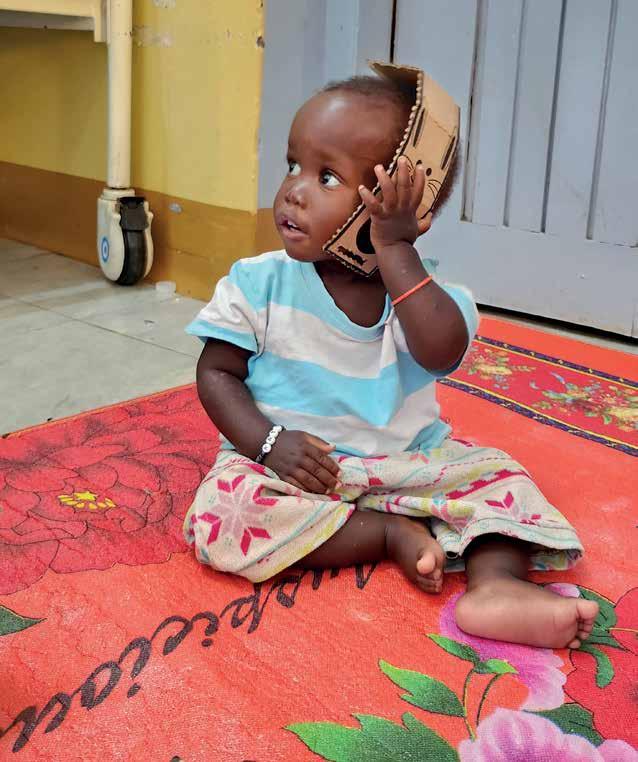
Supply and Logistics Manager, Zimbabwe Country Office
I found a bridge between my passion for sustainability and my profession by studying environmental management. This led me to the concept of the green supply chain, initiating my journey into sustainable procurement.
In response to the healthcare sector’s significant emissions, the Sustainable Markets Initiative Health Systems Taskforce was established at COP26 in 2021 to catalyze substantial and actionable change towards sustainability within the global health supply chain. UNICEF collaborates within this influential group, which encompasses both public and private healthcare sectors, to foster meaningful transformations. This taskforce unites an alliance of CEOs and leaders from prominent organizations, alongside national and international health authorities such as UNICEF, the National Health Service England and the World Health Organization (WHO). Together, they are committed to implementing scalable actions across corporates such as bundled green power purchase agreements (PPAs) in China and India aimed ultimately at achieving net-zero healthcare, thereby enhancing individual, societal and planetary health.
In Zimbabwe, my drive to integrate sustainability into our procurement processes took shape. We conducted a market survey, and established a sustainability-focused supplier database. This was part of broader efforts to raise awareness about sustainable procurement within UNICEF, across the United Nations Procurement Working Group and even within the private sector.
It is about making a real difference, whether through large-scale surveys or ad-hoc initiatives we have undertaken, such as the introduction of solar-powered tricycles for deliveries, sidestepping the environmental cost of conventional motorbikes.
It is incredible to see the shift in mindset towards sustainability. It is not only about immediate impacts. It is also about influencing long-term policy and market behaviour, making sustainability a core aspect of procurement.

DIGITALIZED SUPPLY CHAINS LEAD TO ENHANCED TRANSPARENCY AND EFFICIENCY, MORE EFFECTIVE COLLABORATION WITH PARTNERS ALONG THE SUPPLY CHAIN AND MORE AGILE, REAL-TIME ANALYTICS AND SCENARIO PLANNING, ENSURING QUICKER AND MORE EFFECTIVE DELIVERY OF ESSENTIAL SUPPLIES.
A boy studies on his computer at the Digital Learning Centre established by UNICEF in Zaporizhzhia, Ukraine. © UNICEF/UNI509132/
Digitalizaton has been a key component of UNICEF supply work for the past decade, formalized as the UNICEF digital supply chain initiative as of 2022. In 2023, 15 out of 34 digitalized projects progressed from initiation or pilot phase to active use. These projects are categorized into three primary work areas:
• Digitalizing processes to enhance accessibility of information by automating data entry and analysis and speeding up data handling.
• Driving supply chain efficiency using digital tools to foster collaboration and data sharing among supply partners across the supply chain.
• Activating data to make it more interpretable and actionable, promoting real-time adjustments and bolstering decision-making.
Optimizing supply chains through digitalization reinforces UNICEF’s commitment to deliver on its mandate for every child.
MANUFACTURER / WAREHOUSE
PROCUREMENT
SALES ORDER AND BUDGET
DEMAND PLANNING AND FORECAST
TRANSPORT
Digital forecast UNICEF COUNTRY OFFICE WAREHOUSE
Electronic vaccine quality arrival report
Warehouse demand planning system eProcurement mobile Warehouse and Inventory Management Solution (mWIMS)
TRVST
TRANSPORT TO IMPLEMENTING PARTNER
ACKNOWLEDGE/ RECEIVED BY IMPLEMENTING PARTNER OR GOVERNMENTS
Process enhancement FACILITY LEVEL
Supply chain efficiency
Data activation
Last Mile Supply Monitoring
Access and Coverage Evaluation (ACE)
Kits That Fit
COMMUNITY WORKER END USER
UNICEF reshaped its supply data architecture into the InfoHub, which enables UNICEF to integrate diverse data sets sourced internally or from partners into a secured single system and provides end-to-end visibility and customizable access. In 2023, publicly accessible dashboards powered by the InfoHub provided countrybased and global stakeholders with real-time insights into deliveries and market trends in RUTF and measles-containing vaccine markets.
Granular, real-time visibility is crucial for strategic decision-making in UNICEF’s supply chain work, whether in-country or globally. InfoHub delivers live, cloud-based data, ensuring greater transparency and collaboration and significantly increasing responsiveness to the dynamic needs of development and humanitarian work.
Recognizing its role in managing some of the largest procurement processes across the United Nations system, UNICEF is set to further digitalize them. In 2023, UNICEF laid the groundwork for this transformation by launching a dedicated e-procurement project to pursue the next level of digitalization for procurement processes to simplify, streamline, automate and integrate current systems with new solutions into a holistic end-to-end eProcurement ecosystem. This project is supported by strategic funding and a robust structure, including a core team and over 80 focal points from various UNICEF offices. The initial project phase, conducted in 2023, focused on a comprehensive assessment towards enhancing efficiencies. This meticulous evaluation is pivotal for developing a tailored solution that boosts procurement processes while continuing to uphold ethical and supplier diversity standards, marking a significant step forward in UNICEF’s commitment to operational excellence and sustainability.
UNICEF is advancing its procurement processes with innovative technology to automate time-intensive operations. In 2023, UNICEF integrated a tool directly into its internal data management system, simplifying the signature process and marking a significant step towards full automation.
In 2023, the robotic process automation (RPA) pilot demonstrated the reliability of bots in performing routine procurement tasks, such as compliance checks, saving time and considerable manual effort. With multiple opportunities identified for further automation, this pilot paves the way for broader application of RPA across UNICEF’s contracting processes, setting the stage for more efficient, tech-driven operations.
In 2023, UNICEF introduced a cuttingedge demand planning and forecasting system designed to significantly enhance its tactical demand planning capabilities. This system will enable the efficient balance of supply and demand fluctuations, reduce supply chain disruptions, facilitate regular and updated forecast sharing with suppliers, and ultimately generate cost savings. Additionally, it will offer UNICEF country offices near real-time visibility into demand materialization, marking a significant step forward in achieving operational efficiency. A second project will introduce a digital platform to collect country office forecasts, streamlining the submission process and making review validation more efficient.

In 2023, UNICEF launched an assessment to determine the scope and budget required to implement a Procurement Services Partner Portal to streamline the historically complex management of standard UNICEF Procurement Services transactions, while simultaneously enhancing communication, collaboration and transparency between UNICEF and its stakeholders.
If implemented, a portal would revolutionize UNICEF’s Procurement Services by boosting operational efficiency, leveraging data for continuous learning and risk reduction and strengthening partnership for every child amidst evolving demands and challenges.
Procurement Services partners are empowered to manage their interactions with UNICEF more effectively, thanks to a user-friendly interface that provides easy access to both historical and current information.
UNICEF regional and country offices can access data and submit requests on behalf of procurement services partners. The centralized system is expected to save time and reduce duplication, streamlining procurement.
Children continue their
Enhanced reporting
Improved reporting capabilities enable UNICEF to make betterinformed decisions and provide donors and partners with improved access to reports.
All relevant documents, such as cost estimate documents, Memoranda of Understanding and Statements of Account, are shared on the platform, improving document management and enhancing transparency and accountability.
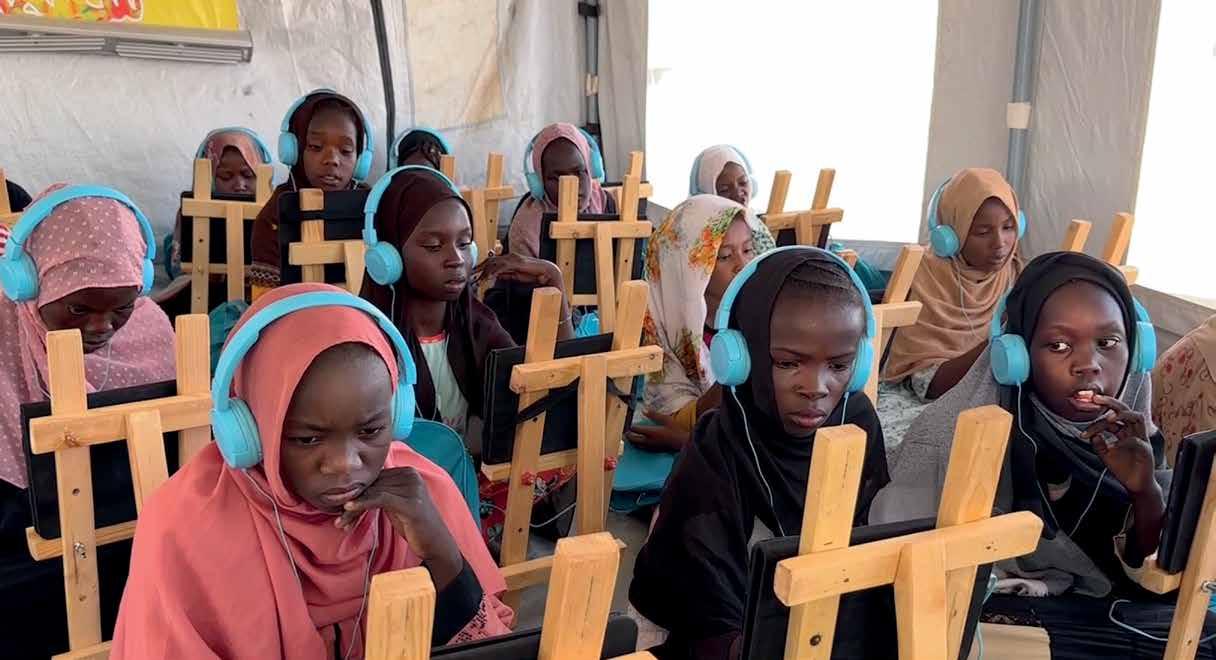
In supply chain management, the last mile describes the difficult final part of the transportation of supplies from hubs to their final destinations. Monitoring of this crucial phase often relies on collaborations with government and civil society partners who can access health centres, schools and refugee camps – areas that typically have poor connectivity and limited tracking capabilities. A reliance on traditional paper trails to monitor batches is complicated, overly manual, and does not easily provide insight into how supplies were used.
In response to these critical challenges, UNICEF introduced the Last Mile Supply Monitoring solution, an innovative blend of technology and streamlined processes designed to enhance transparency and efficiency. This solution features an app that allows inputs via desktop and mobile devices and generates visualization dashboards.


In 2023, the Last Mile Monitoring app was successfully piloted in Lebanon, Mali, the Philippines, Syria, Ukraine and Venezuela. The system operates by syncing supply information from UNICEF’s internal database directly to the app. This allows for real-time confirmation of supply receipt and tracking of movements to final destinations, detecting potential diversions along the way. Real-time monitoring enables users to assess performance and provides visibility that empowers communities.
Supply and Logistics Officer, UNICEF Mali Country Office
We initiated the pilot for the Last Mile Supply Monitoring app in 2023, marking an important step for us in Mali.
The app is a decision-making tool for country-level decision makers to inform the way forward to address programmatic, supply and investment-related challenges.
Typically, the responsibility falls on staff like nurses or accountants, who, while experts in their field, are not specifically trained in logistics and have to rely on paper trails for tracking, which is not efficient.
From our pilot, it is clear the app holds promise by simplifying stock management and ensuring supplies reach their destination. As we look to expand, one major consideration is enhancing capacity among those at the end of the supply chain, who might not have a logistics background. Training and providing simple, effective tools through supportive supervision will be crucial for success in remote areas.
I am deeply convinced of the value of this app and excited about the opportunities it represents for reaching the children we serve.
In 2023, TRVST continued to improve patient safety to instantly authenticate medical supplies using a mobile app supported by barcoding technology. Building on its foundation as a multistakeholder consortium, including Gavi, the Vaccine Alliance, BMGF, the Global Fund, USAID, the EU and the World Bank as well as low- and middleincome countries Nepal, Nigeria and Rwanda, TRVST expanded its scope beyond COVID-19 vaccines to include other health supplies, showcasing the transformative impact of collaborative efforts on supply chain efficiency and safety.
This collaborative effort not only bolsters the authenticity and safety of vaccines and other health supplies but also showcases the power of partnerships in enhancing global health security and supply chain efficiency.
A girl plays with a hula hoop in a safe space provided by UNICEF and its partners in Guatemala.
© UNICEF/UNI452351/ Izquierdo

UNICEF global procurement statistics
UNICEF procurement by country/area of invoice and US$ value, aggregating local, country-to-country, and international procurement.
UNICEF procurement by country/area, supplier, and category, giving separate US$ values for local, country-tocountry and international procurement (orders with a combined value of over $100,000).
Destination countries/areas for UNICEF procured commodities, aggregating local, country-to-country and international procurement.
Destination countries/areas where services were used, aggregating local, country-to-country and international procurement.
Number of companies invited to bid by UNICEF Supply Division for international procurement responses received by country/area.
Annexes of the UNICEF Supply Annual Report 2023 are accessible by scanning the QR code or following the URL: https://www.unicef.org/supply/ media/21526/file/Annexes-SupplyAnnual-Report-2023.pdf
Supplies and services procured by country offices for local delivery and subject to the principle of competitive bidding from local suppliers.
Supplies and services procured on behalf of another country, or international procurement by country or regional offices, and subject to the principle of competitive bidding.
Supplies and services procured by Supply Division, or by country offices through Direct Order arrangements, or by other headquarter divisions, and subject to the principle of international competitive bidding.
For a list of contracts awarded at or above the value of $100,000 by UNICEF Supply Division, visit www.unicef. org/supply/contract-awards
For further information on the work of UNICEF in markets to secure the rights of children, visit www.unicef.org/supply/ influencing-markets
UNICEF Supply Division
Oceanvej 10–12
2150 Nordhavn Copenhagen Denmark
Telephone: +(45) 45 33 55 00
Email: supply@unicef.org
unicef.org/supply
/unicefsupply
@unicefsupply
/unicefsupply
@unicefsupply
@unicefsupply
UNICEF Supply Annual Report 2023
ISBN 978-92-806-5547-6
© United Nations Children’s Fund (UNICEF)
April 2024